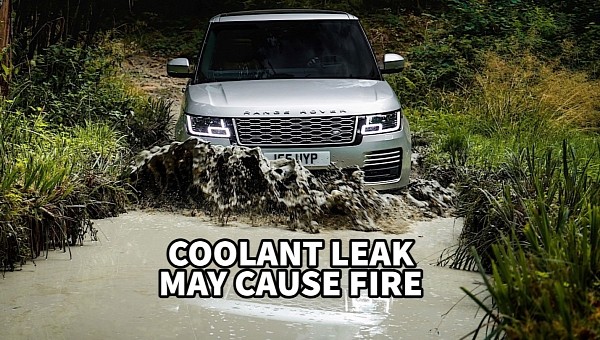Purchased by Tata Motors in 2008 with Jaguar in tow, Land Rover isn’t exactly a byword for world-class reliability. The British automaker had reliability issues for a long time now, often caused by poorly designed components. Part number H4P3-8B535-A that equips certain plug-in hybrids, for example, a coolant outlet tube that forced Land Rover to recall 2,300 units of the Range Rover PHEV and Range Rover Sport PHEV.
Following multiple reports of vehicle fires, the British automaker opened an investigation in May 2021 to determine the possible causes of those thermal events. The engineering division couldn’t determine any definitive root cause whatsoever until late 2022.
As it happens, four-cylinder gasoline plug-in hybrid powertrains feature a water pump drive pulley belt that may become damaged. A detached belt results in less coolant flow. The overheating 2.0-liter engine leads to the rupture of a plastic elbow of the coolant system, which results in coolant flowing onto the turbocharger’s heat shield. This condition ultimately concludes in a localized fire that may engulf the whole vehicle.
Supplied by automotive components manufacturer AKWEL, the suspect engine coolant elbow will be replaced by authorized retailers at no cost whatsoever to affected owners. Land Rover will notify dealers of this recall on April 13th, whereas affected owners will be informed by first-class mail no later than May 26th.
Dealers will also replace the turbocharger feed coolant pipe out of an abundance of caution. Of course, owners who incurred costs replacing these parts before this recall are eligible for reimbursement. Land Rover does mention in the report attached below that the replacement elbow features an improved design, but doesn't say a word in regard to the replacement pipe.
Land Rover couldn’t be bothered anyway because few people actually spend their hard-earned cash on a leviathan of a luxury sport utility vehicle powered by such a puny engine. The British automaker is also focused on churning out as many new-gen Range Rovers as possible. Both the full-size Range Rover and Range Rover Sport have been redesigned last year on the MLA-Flex platform for longitudinal engine applications.
Land Rover also understood that more cylinders and more displacement are needed in vehicles this heavy, hence the adoption of a 3.0-liter turbocharged straight-six lump available as is or with plug-in hybrid assistance. The plug-in hybrids are dubbed P440e and P510e, with P standing for dino juice and the numbers in the middle referring to metric instead of mechanical horsepower.
Over in the United States, where 2018 to 2021 models produced between May 2017 and August 2021 are called back, the Range Rover and Range Rover Sport in plug-in hybrid flavor are currently priced at $110,500 and $104,200 sans the $1,475 destination and delivery charge. The United States market, unfortunately, doesn’t get the more powerful of the aforementioned plug-in hybrid engines, at least not for the 2023 model year.
As it happens, four-cylinder gasoline plug-in hybrid powertrains feature a water pump drive pulley belt that may become damaged. A detached belt results in less coolant flow. The overheating 2.0-liter engine leads to the rupture of a plastic elbow of the coolant system, which results in coolant flowing onto the turbocharger’s heat shield. This condition ultimately concludes in a localized fire that may engulf the whole vehicle.
Supplied by automotive components manufacturer AKWEL, the suspect engine coolant elbow will be replaced by authorized retailers at no cost whatsoever to affected owners. Land Rover will notify dealers of this recall on April 13th, whereas affected owners will be informed by first-class mail no later than May 26th.
Dealers will also replace the turbocharger feed coolant pipe out of an abundance of caution. Of course, owners who incurred costs replacing these parts before this recall are eligible for reimbursement. Land Rover does mention in the report attached below that the replacement elbow features an improved design, but doesn't say a word in regard to the replacement pipe.
Land Rover couldn’t be bothered anyway because few people actually spend their hard-earned cash on a leviathan of a luxury sport utility vehicle powered by such a puny engine. The British automaker is also focused on churning out as many new-gen Range Rovers as possible. Both the full-size Range Rover and Range Rover Sport have been redesigned last year on the MLA-Flex platform for longitudinal engine applications.
Land Rover also understood that more cylinders and more displacement are needed in vehicles this heavy, hence the adoption of a 3.0-liter turbocharged straight-six lump available as is or with plug-in hybrid assistance. The plug-in hybrids are dubbed P440e and P510e, with P standing for dino juice and the numbers in the middle referring to metric instead of mechanical horsepower.
Over in the United States, where 2018 to 2021 models produced between May 2017 and August 2021 are called back, the Range Rover and Range Rover Sport in plug-in hybrid flavor are currently priced at $110,500 and $104,200 sans the $1,475 destination and delivery charge. The United States market, unfortunately, doesn’t get the more powerful of the aforementioned plug-in hybrid engines, at least not for the 2023 model year.








